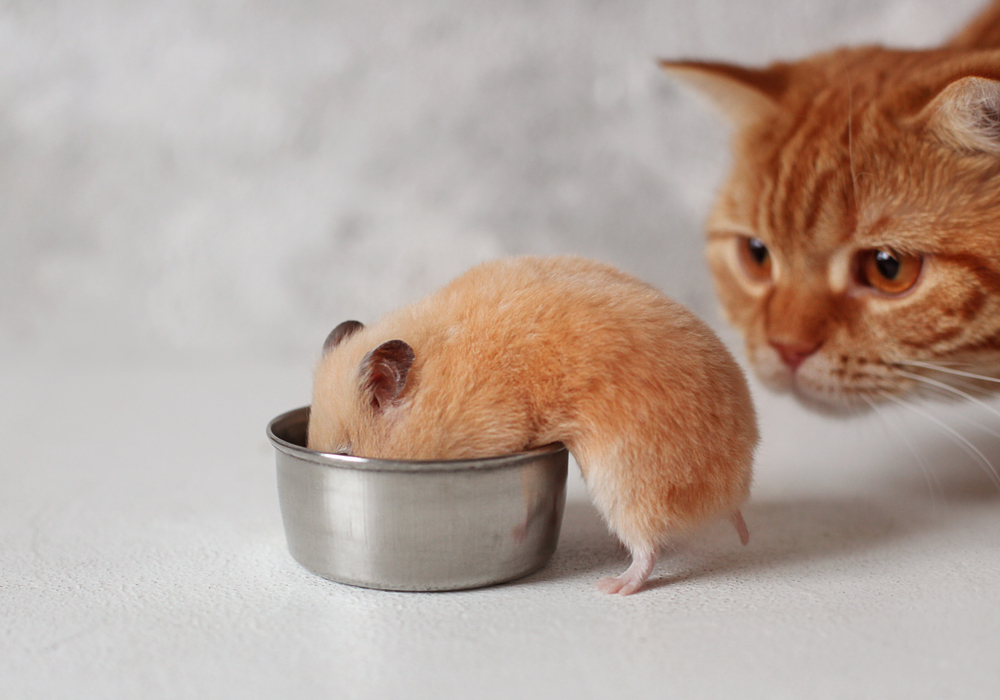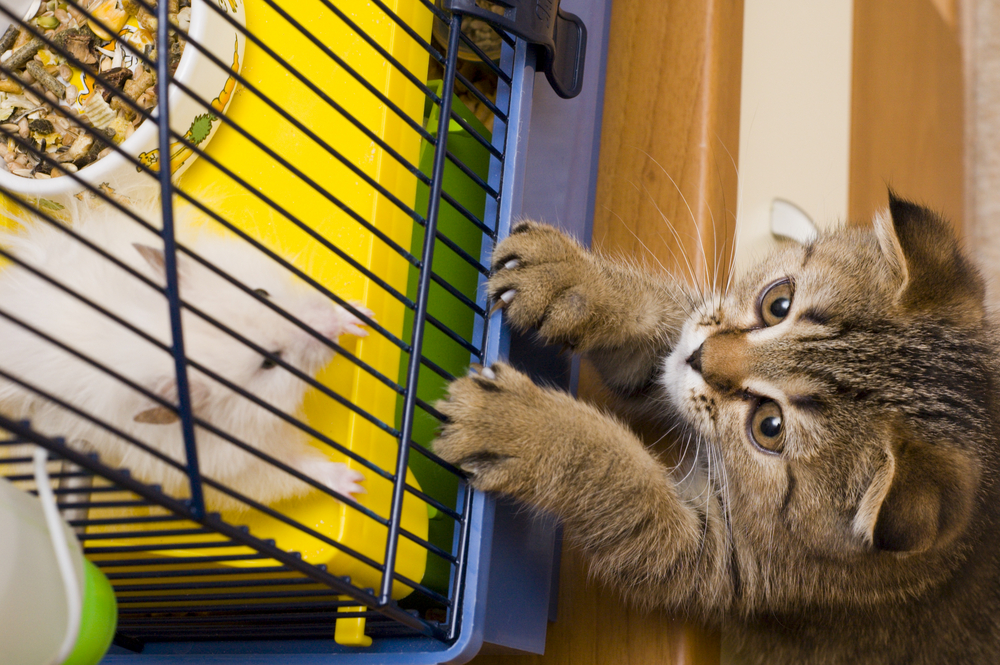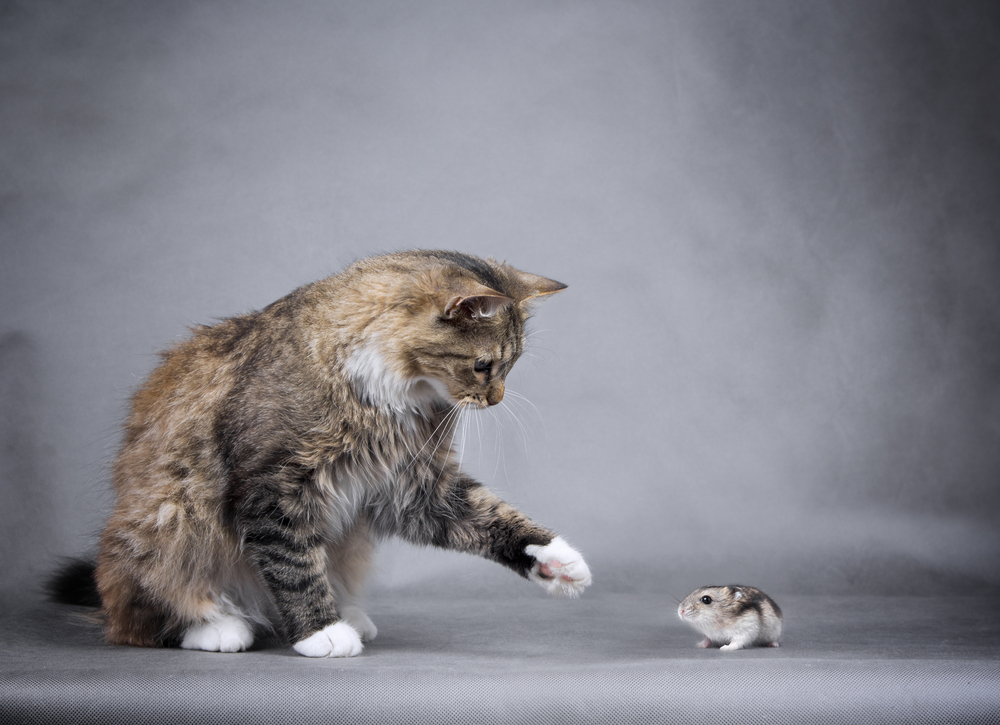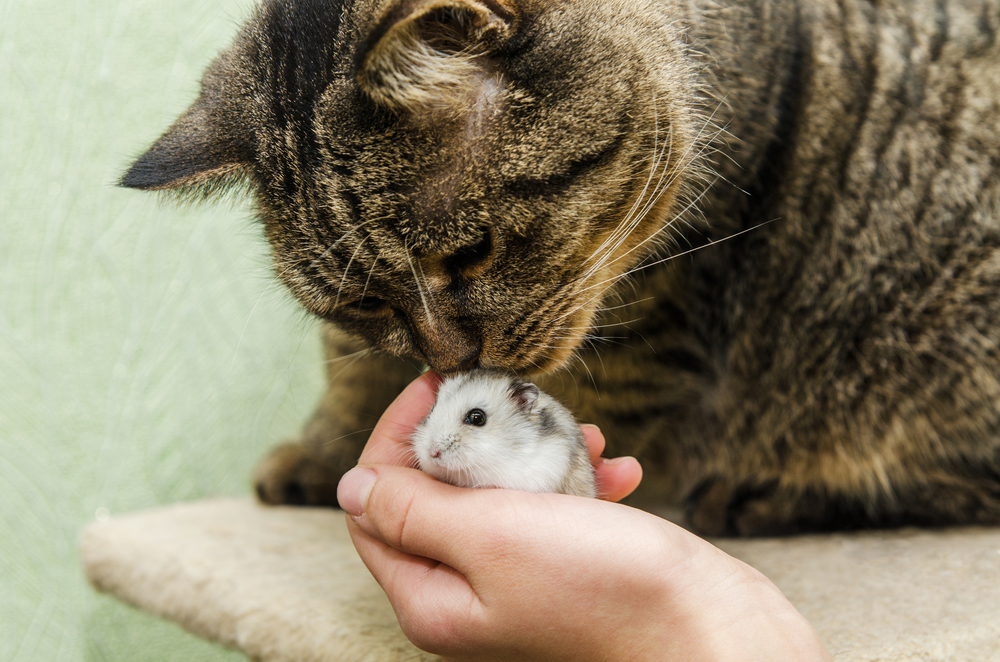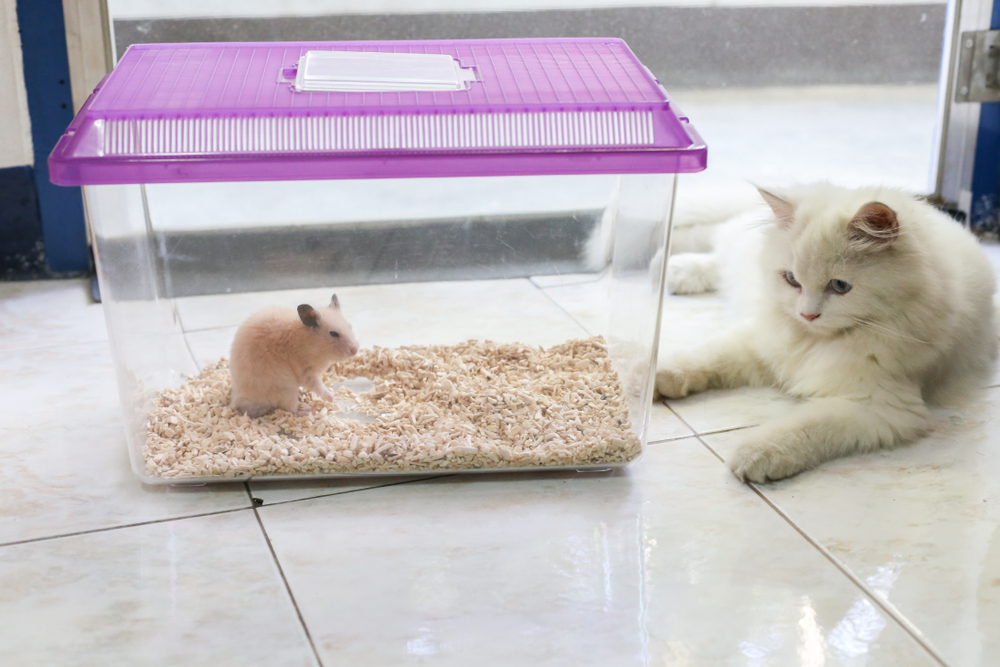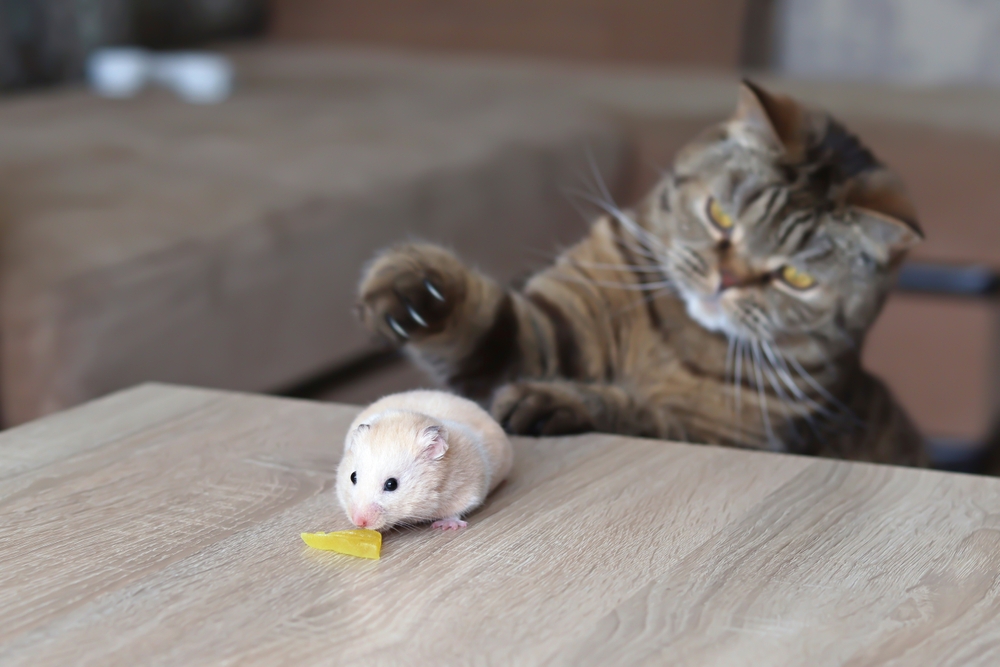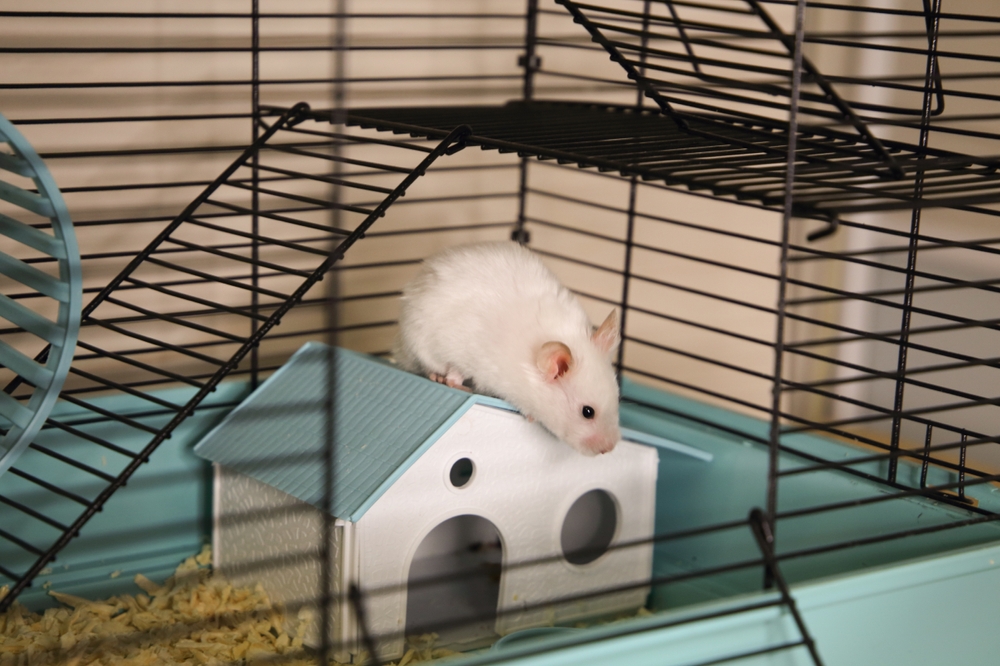📖 Table of Content:
Everyone is familiar with the rivalry between a dog and a cat. It’s a tale as old as time! But what about felines and let’s say… hamsters? Do cats eat hamsters?
For many people, a home full of different kinds of pets is a dream come true. That’s all fun and games when you’re young, but once you grow older you start to realize that not all animals get along.
However, this doesn’t mean that you should give up your dream of owning different pets (if of course, that is your dream). There’s always a way to make things work. But how? Let’s find out!
Cats vs. hamsters: the difference in their temperament
Apart from obvious physical and biological differences, cats and hamsters significantly differ in the way they behave and interact with their surrounding.
Understanding these differences can be very useful if you are considering bringing these two animals together and making them roommates.
Cats
As we all know, our beloved feline buddies love to be the rulers of the home they are in. They are extremely territorial and crave full dominance over their home.
They also love to interact with their humans and show their affectionate side. Some of them are cuddlier and tend to enjoy the lap time a lot more than other felines do, but generally speaking, every cat builds some type of relationship with their owner.
Some of them are also very active and playful. They love to chase the toys that you throw, munch on your toes, jump around and climb on top of the furniture, and explore every nook and cranny of your home.
Cats are also masters of sleep and can doze off in any place and almost any position. They are crepuscular creatures by nature, which means that they are more active around dusk and dawn.
All in all, cats are great life companions, and being given a chance to get to know them is definitely one of life’s many pleasures.
Hamsters
Hamsters on the other hand are nothing like cats. They don’t need to have access to every room of their owner’s home, but rather a small cage-like compartment where they can feel safe and content. So basically, that enclosed habitat their owner provides is their own little house.
Unlike cats, hamsters don’t need to cuddle or play with their owners. They are perfectly fine on their own and can (and will) survive if they’re left alone. As long as they have enough food and water, of course.
Sure, they can play or cuddle when their owners insist, but they don’t necessarily need human interactions to have a happy and healthy life. They can pretty much entertain themselves with all those ramps and wheels inside their little cage.
Hamsters are nocturnal creatures by nature. They usually sleep during the day and eat and play during the night. However, this doesn’t stop them from creating a bond with their owners. Many people enjoy hamsters as pets and find them extremely adorable and very interesting.
Do cats eat hamsters?
Well, hamsters are rodents, and we all know that these animals are one of the favorite meals of our beloved feline friends. So, the answer to the question “Do cats eat hamsters?” is a resounding yes.
Cats are, of course, obligate carnivores. This means that they absolutely require meat in their diet, with a small addition of carbohydrates and minerals.
Feral cats usually feed on small animals like birds, squirrels, and rodents that they hunt themselves, while indoor fluffs get served delicious canned food, which is usually based on poultry or cattle.
Cats are also natural hunters and predators, which makes hamsters their natural prey. I understand that you don’t necessarily imagine a bloodthirsty killer when you see your slightly overweight and spoiled fluff lounging on your living room couch, but deep down, her predatory instincts are still there.
I know that the thought of your cat eating your hamster is not very appealing. But trust me – your kitty feels the same. As long as your fluff gets all the necessary nutrients in her diet, she will not eat your hamster.
However, this doesn’t mean that she won’t try to hunt and pounce him. She might not see him as her next real meal, but she will most definitely see him as her prey, as something to catch in order to come out of it as the ultimate winner.
Will a hamster survive a cat bite?
Hamsters are way smaller than cats, and they view them as their predators. That means that a hamster will never come in close contact with a cat, but rather try to avoid her altogether.
However, as previously mentioned, any kitty will use any chance to act upon her hunting instincts and try to get her little paws on a tiny hamster. She might not eat him, but she’ll definitely stick her pointy teeth into his flesh.
The problem is that a cat bite is not at all harmless. All felines carry certain harmful bacteria in their mouths, like the extremely pathogenic Pasteurella multocida, for example. This bacteria can often cause tissue infections in bite wounds.
So, if your hamster gets bitten by your cat, and you don’t treat the bite immediately, he might not survive.
The cat bite has to be momentarily disinfected and the hamster taken to the vet. The vet will probably prescribe certain medication for him and require you to monitor his condition.
Bear in mind that a feline scratch can have a similar effect.
Can you own both a cat and a hamster?
Nothing’s impossible for true pet lovers!
There’s no reason why you shouldn’t own both a cat and a hamster. Sure, you’ll need to watch your kitty and make sure she overcomes her hunting instinct, and also make a few adjustments in your home.
But all in all, your cat and your hamster can easily be friends! Okay, maybe just acquaintances, but still on good terms.
How can you introduce them to each other?
The key to this unusual friendship is the way you introduce them to one another.
First things first, let them observe each other at a safe distance and with proper barriers. Make sure your hamster is in his cage, and your cat in her carrier or on a harness.
By allowing them to observe one another, they’ll get used to each other’s looks and scent, and you’ll have a chance to see whether your kitty has strong hunting urges toward the hamster.
Once that’s done, you can proceed with the next step, which includes allowing them to properly sniff each other. With this step, you’ll have to be extremely careful and patient since it might take days until your kitty stops acting aggressively.
Also, bear in mind that you might never move past this step, which is completely fine. There’s no need to rush anything. If it doesn’t work – it just doesn’t.
On the other hand, if your cat and your hamster seem fine, the next thing you can do is allow them to be in the same room without any barriers. However, this doesn’t mean that they shouldn’t be supervised, but rather that they can roam freely around the room without being held.
Once you’re done with the introductory part, I advise you not to fully trust your kitty’s tolerance of the hamster. You should still pay attention to how she reacts to him and ensure he is always safe and out of her reach.
How can you ensure your hamster is out of your feline’s reach?
1. Use the right type of cage for your hamster
Hamsters are great at escaping, so your little fella should have a safe and secure cage. Especially if he has a feline sibling lurking in your home.
Your hamster’s cage should be made out of durable materials, so your kitty doesn’t chew it off in an attempt to reach the hamster. The cage should also have small slats, so your feline intruder can’t stick her furry paw inside.
Also, the doors of the cage should always be tightly shut. Cats are very intelligent creatures, and it doesn’t take them long to figure something out, like how to open the door to their favorite prey.
2. Watch where you place your hamster’s cage
No, this doesn’t mean you have to place your hamster’s cage on the highest shelf in your home. Cats are famous for their climbing abilities, height preferences, and knocking things over.
If you place the cage on a shelf, your kitty might climb up and attempt to knock it down, which can result in the doors flying open.
Place the cage somewhere where your cat can’t reach it, and make sure it is secure enough, so she can’t possibly knock it over.
3. Separate them into different rooms when it’s time to play
If you feel the need to get your hamster out to cuddle or play with him, make sure your fluff is in another room. Just in case!
4. Train your kitty
This one especially applies to kittens. If your cat is still very young, you have all the time in the world to teach her how to behave around your hamster.
